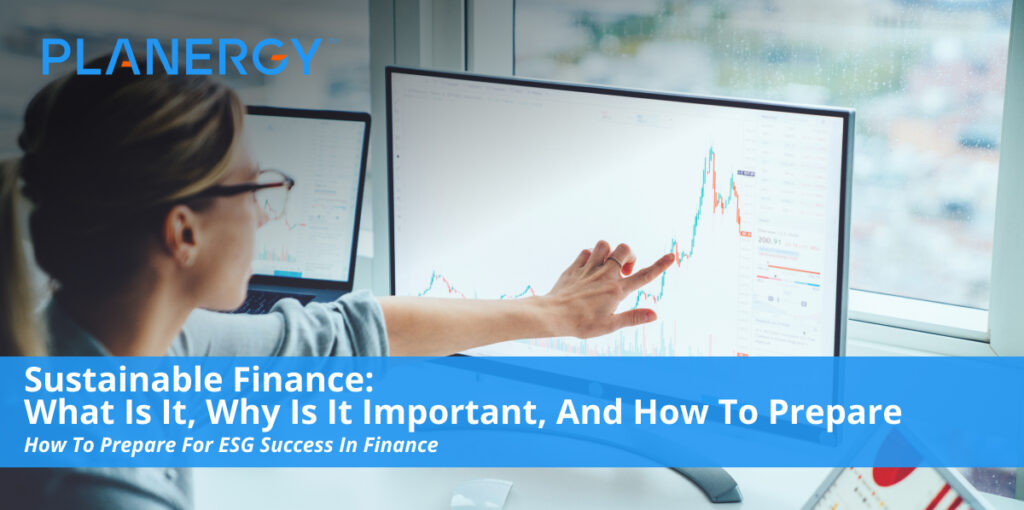Sustainable Finance and ESG Strategy
Sustainable finance and ESG strategy in particular are becoming an important component for business owners, consumers, and investors.
With corporate actions and behavior on very public display due to social media, more corporations are embracing sustainability for numerous reasons, not the least helping to build their reputation.
Organizations are also embracing sustainability because it’s becoming more important to both customers and investors that the companies that they invest in are socially responsible.
What is ESG Strategy?
An ESG investment strategy incorporates environmental, social, and governance issues when considering investments.
For example, as climate change becomes a more immediate threat, more investors are looking to invest funds in both organizations and products that promote a more sustainable future; particularly those that are supporters of climate change initiatives.
Corporate scandals and misdeeds have also driven more investors to put their money in companies that share their values as well as those that can earn them a profit.
What are the three main elements of financial sustainability?
Financial sustainability is a broad term whose meaning can vary from organization to organization.
That’s why many institutional investors, asset managers, and financial institutions like using ESG strategy when making investment decisions.
There are three main elements to ESG.
- Environmental
- Social
- Governance
Each of these elements is considered by investors when looking to make investment decisions.
This chart displays some of the issues that can occur under each of these elements.
| Environmental | Social | Governance |
| Energy usage | Employee welfare | Transparent accounting |
| Toxic emissions | Healthcare initiatives | Investor relationships |
| Compliance with regulations | Gender equality | Business ethics |
| Natural resource conservation and biodiversity | Race equality | Political influence |
| Climate change | Religion equality | Legal practices |
| Carbon footprint | Human rights monitoring | Whistleblower policy |
| Use of ecosystems | Poverty and community impact | Shareholder rights and engagement |
| Environmentally friendly products | Customer privacy | Code of conduct and business principles |
What is the difference between sustainable finance and ESG?
Though sustainable finance and ESG (environmental, social, and governance) finance are often used interchangeably, sustainability is a more general term that can mean anything many things including addressing climate risk, constructing a green building to creating a low-carbon footprint.
ESG finance is more granular, with its focus centered on three very specific areas; environmental, social, and governance, with specific criteria set in each of those areas that need to be met to be considered ESG investing, unlike sustainability, which can mean different things to different organizations.
Today, consumers are much more likely to purchase goods and services from companies that share their values. Corporate purpose is also important, with consumers choosing to purchase from companies that have a strategic purpose that is important to them.
Why is sustainable finance important?
In the past, investors had to decide to either make money or help the environment.
But with sustainable finance and ESG investing, the decision-making process has changed, with more investors looking to put their funds into an organization that will leave the world a better place while enjoying even better returns.
But what is the motivation for a company to invest millions or even billions of dollars to become more sustainable?
Primarily their customer base. Today, consumers are much more likely to purchase goods and services from companies that share their values.
Corporate purpose is also important, with consumers choosing to purchase from companies that have a strategic purpose that is important to them.
But even more telling, if the company(s) that they currently support veers off course, those same consumers are likely to stop purchasing goods and services from them, while encouraging friends, family, and associates to do the same.
But it’s not just companies that are enjoying the benefits of ESG and sustainable finance. Many organizations have found that investors are actively searching for an opportunity to invest in a business where their values are similar.
To that end, sustainable finance is a win for companies, investors, and consumers alike.
What is the advantage of sustainable finance for investors?
Investors are making more investment decisions using a values-based set of criteria.
But whether investors envision a healthier planet for their descendants or just want to make the world a better place right now, it makes sense to look into an investment that can not only provide a healthy return but also aligns with core values.
But along with supporting a sustainable business model, economic growth is important to investors as well.
Larry Fink, Chairman and CEO of BlackRock, a worldwide investment and advisory firm states in his annual letter to CEOs in 2022, that sustainable investments have now reached $4 trillion, while during the height of the pandemic in 2020. He also notes that eight out of ten sustainable investment funds performed better than those that did not include ESG investing.
For investors, ESG investments address intangible issues such as brand value and the importance of customer loyalty but also considers the impact of ethics scandals and safety breaches on their investments.
How to get started in ESG investing
Following an ESG strategy can be a wise investment, monetarily, environmentally, and socially.
With its popularity rising, numerous mutual funds, brokerage firms, and even robo-advisors are now offering products that currently use ESG investing strategy.
This strategy looks at how organizations score on both environmental and social responsibilities, looking at each element for the following:
- Environmental – Many environmental factors are evaluated when determining whether an organization is following ESG strategy. These include the level of impact a company has on the environment. This evaluation can include carbon footprint, level of toxic waste and how it’s handled, and other sustainability factors including conservation efforts, water usage, and current waste management strategies.
For example, consumers frown on animal testing on cosmetics, leading to a shift away from this once-common practice.
The same goes for companies that have a history of contaminating soil or watersheds.
- Societal – Social impact is more important than ever before. Before purchasing a product or service, more consumers than ever before are studying the company’s social blueprint to see if its societal impact is inclusionary. This includes taking a look at LGBTQ standards, where the company stands on racial diversity overall, as well as at the executive level. Other issues taken into consideration are hiring practices and whether the company actively advocates for social good as part of the long-term organizational strategy.
For example, many larger corporations have a community services arm, where they undertake various projects such as community clean-up efforts.
These type of activities keep the business involved in the community and lets customers and investors see where their priorities lie.
- Governance – The last of the elements, governance is perhaps the most important element, simply because how an organization is governed plays a large role in how environmentally or socially responsible they are. Here, things such as how the board and management work together to drive change are carefully scrutinized. Board diversity is also an important factor that is closely looked at. Finally, pay discrepancy and executive versus employee salaries are looked at, as well as how well company leadership interacts with and responds to its shareholders.
Today, investors especially want to see the makeup of the board. Are minorities represented in the board makeup? And both consumers and investors alike frown on political contributions that are used to obtain favor.
Though one of these elements may be more important to some investors than others, today, many investors are insisting that all three elements be present in any company that they invest in.
But it’s not only investors that are seeking out ESG strategies.
Consumers also look for these elements in companies that they choose to do business with. Now, more than ever, customers are driving social change with the power of their dollars.
But how do you communicate these activities to your investors and customers? By using ESG reporting.
What is ESG Reporting?
While the first step in an ESG strategy is to implement environmental, social, and governance changes internally, the second part of that equation is reporting ESG performance.
Disclosing processes allow agencies to determine how successful your company has been in implementing ESG strategy and provides both investors and customers with a look at both targets and goals.
Providing this information provides customers with a way to make more informed buying decisions, and gives investors a much-needed snapshot into company ESG performance before they invest.
ESG reports should include both qualitative disclosures including the ESG elements that the company has adapted, as well as qualitative data regarding how well the company is meeting established goals.
For example, if your business always boasts of its environmental record, stakeholders such as investors and customers want to see how much waste was managed, whether your factories emit dangerous pollutants, and what your carbon footprint is.
Why is ESG reporting important?
There are numerous reasons why ESG reporting is important.
Trust
Before a customer purchases products or services from you, they must trust you. Voluntarily releasing ESG reports allows customers to view what values your business holds and what you consider important.
By connecting to your customers through ESG reporting, you connect with others who share the same values.
Accountability
Anyone can say that they care about the environment, treat all of their employees fairly, and have a diverse management team and board that represents all people. However, ESG reporting gives companies a way to share ESG initiatives and results with all of their stakeholders.
Transparency
Investors in particular are looking for ESG reporting that includes quantitative data. While it’s important to share goals with investors, they also want to see what progress has been made towards reaching those goals.
Today, there is no set ESG reporting standard, though various global agencies are working to create an ESG framework that both private and public businesses can use.
What does the Sustainable Finance Center do?
In 2018, The Toulouse School of Economics in France launch the Sustainable Finance Center. The center currently has more than 40 scholars working in a variety of areas including finance, environmental economics, macroeconomics, psychology, and public economies to address the challenges faced by firms, policymakers, and the general public regarding sustainable finance. Their research focus includes the following:
Responsible finance and long-term investments – This area looks at long-term investments and whether investors are investing in enough long-term assets. Long-term assets are particularly important when looking to address sustainable development goals such as climate change, education, safety, and nuclear risks.
Financial technologies and digital markets – Financial technologies and digital markets look at the impact that new technologies such as cryptocurrency are having on the economy and the investment market. This research includes looking at ways to institute risk management strategies for potential issues such as possible market failures.
Financial intermediaries and regulation – Financial intermediaries and regulation takes a look at current payment systems and regulations as well as financial markets to help consumers and investors better understand financial intermediation.
Financial behaviors, welfare, and markets – Financial behaviors, welfare, and markets look at the strategy behind pricing assets while mitigating risks.
How To Get Started With Sustainable Finance
Companies would be wise to educate themselves before implementing an ESG strategy. Even smaller, private sector businesses would benefit from having an ESG strategy in place. Before you get started, ask yourself these questions.
- Do have a diverse workforce and diverse management team?
- Is your work environment free from discrimination and harassment in all forms?
- Do you practice conservation, use renewable energy, support climate action, and properly recycle trash?
- Are your business practices transparent with all stakeholders and policymakers including employees, consumers, vendors, and investors?
- Do you pay your employees fairly based on merit?
- Is your business compliant with all regulations including equal opportunity, wages, and environmental issues?
Once these questions have been answered honestly, you can begin to create an ESG strategy for your business by setting goals, constructing a framework that will assist with reaching those goals, creating a sustainability team, and promoting your new initiatives to all interested stakeholders.
Sustainable Finance Is The Future
Whether investing in green bonds, sustainability bonds, or energy efficiency initiatives, investing in impact investments can pay off.
Preparing your finance team for these new requirements will definitely pay off in the long run.




